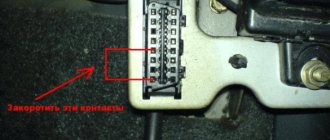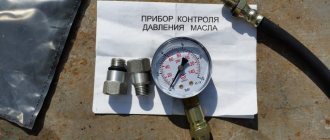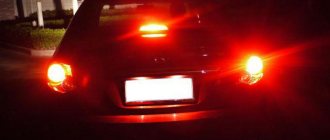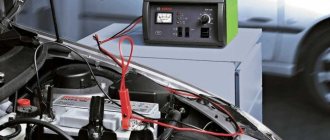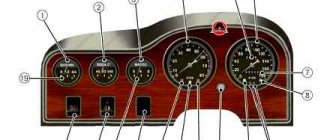The translation of the expression “check engine” in Russian literally sounds like “check the engine.” The “check” icon is on the dashboard of most modern cars, but its meaning remains unclear to many. Therefore, if this icon - a yellow or orange engine icon - appears and does not disappear (or simply blinks), a logical question arises in an inexperienced driver: “what does this mean?” Next, we’ll try to find out the reasons why the check engine light came on on the dashboard of your car, as well as how to get rid of it.
Initially, this light indicated problems with the carburetor, but now that cars are equipped with full-fledged on-board computers, the message may indicate various malfunctions. For example, a “check engine” error may indicate problems with the quality of the air-fuel mixture or ignition faults, as well as many other things. Messages can be caused by both minor and critical failures.
Thus, when the “check engine” light is on, it is only clear that the ECU has detected a malfunction in one of the car’s systems. Only diagnostics can give a complete picture. Next, we will look at the main reasons why the check engine light is on and what needs to be done about it.
CHECK ENGINE
—
Check Engine Check - There's nothing fun or enjoyable about those two words. There is also not much logic that can be derived from this phrase, at least not logic that we understand. What does “Check Engine” mean? Is it something more or less specific? No is not. That's because the Check Engine Light means there's something wrong with our engine, and we can't know 100% what it is under the hood that caused that proverbial light to come on. In general and most common cases, Check Engine means that you will have to communicate with car service workers; in the worst case, if your car is far from young, Check Engine may even mean an upcoming major repair.
FakeHeader
Comments 22
Most likely, when I was fiddling with the filter, I touched the tube on the booster valve; it is installed right next to it.
I have a different scheme
Here is your diagram that is more correct)
Yeah, I downloaded it myself from the net when I had to sort out the vacuum
Greetings. Literally on Wednesday I overcame this scourge. I was also tormented by error 0400 and 1125. On Wednesday I rushed to Minsk on family matters and at the same time stopped by to see a person. First of all, they checked all the connections and changed the vacuum; there was a leak in the booster area (the valve under the turbine is like a barrel) and they let it go by. Look also at the vacuum connection on the receivers above the cabin filter and under the right wheel protection. Well, I went the other way (I’m really tired of this misfortune))) they repaired the EGR and flaps and, of course, the chip firmware))) Now driving is more fun, the eagle has fluttered from the bottom.
If the Check engine indicator light comes on on the dashboard of your car (or simply the “check” is on), you should at least be wary. The reasons for this can be very diverse - from a loose gas tank cap to serious problems with the engine.
The engine stalls, the check light flashes or lights up: the main reasons
Let's start with the fact that injection engines are equipped with special catalyst devices for cleaning the exhaust. At the same time, the catalytic converter is a rather vulnerable and at the same time expensive element, and all sorts of malfunctions in the engine create a risk of damage.
As a rule, the check flashes when there is a risk of damage to the catalyst. In this case, the simultaneous tripping of the engine means that one or more cylinders are not working or are not working correctly. In practice, this means that the fuel in the problem cylinder does not burn completely, after which it enters the exhaust system.
As a result, the remaining unburnt fuel burns out in the area where the catalyst is located, since the temperatures there are very high. Fuel also gets on the catalyst itself, causing it to fail.
It becomes clear that the check often lights up when problems arise with the combustion of the mixture in the cylinders. It is not difficult to guess that such combustion can be disrupted for a number of reasons, ranging from problems with the ignition or fuel supply system to lack of air in the intake, air leaks, reduced compression in the engine cylinder, etc.
It should be added that the check also often lights up in the event of failure of any ECM sensors. One way or another, it is quite obvious that the “check” in the vast majority of cases indicates either problems with the electronic engine control system itself, or the risk of damage to the catalyst due to malfunctions of the internal combustion engine.
It is important to understand that the engine tripping indicates a non-functioning cylinder. In this case, the check is flashing not due to the failure of any ECM sensor, malfunction of the exhaust gas recirculation system or poor fuel in the tank, but rather signals to the driver about a direct threat to the catalyst.
In a nutshell, fuel that is not burned and gets into the outlet causes a special sensor (lambda probe, oxygen sensor) to send readings to the ECU indicating deviations from the norm. The control unit begins to try to correct the situation, but taking into account the tripping, it is simply not able to adjust the operation of the motor so that everything returns to normal. As a result, fuel consumption increases, while the engine operates unstably, idle speed fluctuates, etc. In some cases, the motor “falls” into emergency mode.
This mode is necessary in order to minimize damage to the catalyst and the internal combustion engine itself. In practice, this is expressed in such a way that although the driver presses on the gas, the car in emergency mode with the “check” on still does not accelerate above 30-40 km/h, the crankshaft does not spin up, engine traction disappears, etc.
This feature of engine operation is primarily aimed at preventing burnout or melting of the catalyst. The catalyst itself consists of small honeycomb cells. If unburned fuel intensively enters the exhaust and burns out in the catalyst, the element will simply melt.
This melting will lead to the fact that exhaust gases will not be able to pass normally through the catalyst, that is, a plug appears in the exhaust pipe. Naturally, the engine will “suffocate”, power will drop, the engine may not start at all, etc.
Also, the catalyst will no longer be able to clean the exhaust, and toxicity will increase. There is only one way out in this situation - repairing the engine to eliminate the main cause of the engine tripping, and only then replacing the expensive catalyst with a new one. To minimize risks, a special program is programmed into the ECU, which involves operating the engine in emergency mode.
Causes of engine error
The fact that the check is flashing indicates a danger to the catalyst is understandable. The question “why?” Most likely, when you connect the scanner, you will receive the error p0300 multiple misfires. There may be several reasons for such omissions.
The most undesirable thing, in my opinion, is a burnt valve. When a valve burns out, the engine starts to rough up. Such tripling is usually permanent, since the cause is mechanical. Of course, such a motor pulls very poorly. It is highly not recommended to drive such a car, unless of course you want to change the oxygen sensor and catalytic converter in addition to the valve.
Well, the simplest reason for tripping is the candles. Always carry a spare set of candles with you. Don’t think that a modern car doesn’t need repairs and can’t break down on the road.
In addition to valves and spark plugs, there may be the following reasons:
Individual ignition coils may have a breakdown or an interturn short circuit. This can be determined using a non-contact probe and an oscilloscope program on a laptop. If you have an ignition module, you can check its operation by carefully removing the caps from the spark plugs.
If clicks are heard, then there is a spark; if there are no clicks, the module does not work for this spark plug. Be careful with this check, if the secondary circuit of the module is left without load (move the cap too far from the spark plug) and there is nowhere for the spark to break through, then the switch in the engine control unit can easily burn out.
Carefully inspect the spark plug wells. The presence of water or oil in them is unacceptable. The motor may stall precisely for this reason.
If one or more injectors do not work, the engine will, of course, stall and the check mark will start flashing.
Well, if the timing marks are suddenly knocked down or incorrectly installed, the engine will operate in a mode similar to tripling. But at the same time, there is a spark in all cylinders, fuel also flows through the injectors normally and the check lamp is blinking.
Replacing the oxygen sensor
The appearance of the “check car” message can be caused by damage or improper operation of the oxygen sensor (lambda probe). This element is an important part of the exhaust gas treatment system, which monitors the volume of remaining oxygen after combustion of the fuel-air mixture. If the lambda probe fails, the electronic control unit receives incorrect information, which leads to the following problems:
- Sudden increase in fuel consumption.
- Reduced power of the power plant.
Modern cars are equipped with two or four oxygen sensors, so you will have to use an error scanner to determine the damaged part. If you have such a device in your garage, then checking the engine will be simple.
There are many reasons that cause damage or malfunction of this sensor. One of the most common is coating the part with oil soot, which prevents normal readings. As a result, fuel consumption begins to increase, and the exhaust system emits large amounts of harmful CO2.
When faced with such problems, you need to immediately change the oxygen sensor, otherwise another component, the catalyst, may fail. Repair of the latter is more expensive, which is due to the presence of precious alloys in its composition. And if several catalysts are installed in the car at once, then the total cost of repairs can reach 90,000 rubles. Such significant costs can be avoided if the sensor is replaced in a timely manner.
A new element is also not cheap, but its purchase will cost hundreds of times less than repairing the entire exhaust gas converter system. It is not difficult to replace an element with your own hands. To do this, it is enough to determine where the lambda probe is located and remove it to install a new one.
Why does the “check” light up: the most common and common malfunctions
So, we figured out the general scheme. Now let's look at what problems lead to the check light coming on and the engine stalling. Often a p0300 error occurs, which indicates that a misfire (misfire) is occurring. There are several reasons for these omissions, and to determine them it is necessary to carry out a step-by-step diagnosis, taking into account certain individual symptoms.
- You should start by checking the ignition system. The most common cause of tripping is the failure of spark plugs and armored wires. Candles can wear out their service life, break down, or become heavily contaminated. Armored wires suffer from insulation damage and breakdowns. One way or another, the result is either no spark at all, or there is a spark, but it’s weak.
If everything is in order with the spark plugs and wires, you should pay attention to the ignition module or ignition coils, which may be shorting. In this case, it is better to entrust the check to experienced specialists, since unprofessional actions lead to the fact that you can burn the switch or damage other important elements.
It should also be added that you need to carefully inspect the spark plug wells themselves. Quite often, the engine fails if water accumulates in the wells or engine oil gets there. In some cases, lubricant gets into the wells due to problems with the valve cover gasket.
- Having dealt with the ignition system, it is necessary to check the power system. As a rule, incorrect operation of injection nozzles or malfunctions in their operation lead to engine tripping. At the same time, the check will light up or flash.
The best option would be to check the injectors on a special stand. Such diagnostics allows you to determine the need to clean, repair or replace injectors. At the same time, specialists check the power supply to the injectors, the condition of the injector O-rings, etc.
- As for compression, a burnt-out valve often leads to an unexpected decrease in the indicator. If the valve burns out, the engine starts to run rough. In this case, tripling is constant and occurs in all modes of engine operation. Engine thrust drops significantly, and significant excess fuel consumption is observed.
Please note that in this case you cannot drive the car, as there is a high risk of damaging the catalyst and oxygen sensor (lybda probe). To confirm the diagnosis, you need to measure the compression, and to solve the problem itself, you need to remove the cylinder head, troubleshoot the head and change the valve.
It is worth noting that most causes of the malfunction can be diagnosed with a scanner. An inexpensive device will cost even less than a visit to a service station, without taking into account the time saved. For example, you can consider the multi-brand scanner Rokodil ScanX
With its help, you can easily determine the exact cause of the malfunction. For example, if we are talking about misfires in cylinders or a problem with injectors, the scanner will more accurately indicate the location of the faulty element (P0301-P0304 - misfires in cylinders 1-4 and similarly with injectors P0200). The serviceability of the catalyst can be checked down to the degree of its contamination, based on the readings of oxygen sensors, which can be checked in real time. Rokodil ScanX is compatible with most cars and can help out in difficult situations more than once.
How serious can the reasons be?
Each signal on the car panel is an indicator that the driver must be attentive. When the check engine light comes on, there are several reasons.
- A common cause is gasoline. Due to the additives that unscrupulous manufacturers use in gasoline, the engine does not work properly and becomes clogged. You should change the fuel or refuel at another gas station, and everything works correctly.
- Faulty spark plugs.
- Broken ignition coil.
- A faulty oxygen sensor (lambda probe).
- Broken exhaust catalyst.
- Incorrect operation of high-voltage conductors.
- Malfunction of injectors.
- Fuel pump or fuel filter.
The check should begin with the fuel tank filler cap. If it is not tightened completely or there are defects on it, then the light indicates that the engine is not operating properly.
Each of the reasons is not very scary, but requires immediate elimination. If you do not pay attention in time and do not diagnose the malfunction, you can lead to complete engine failure and incapacity of the machine.
The engine is serious business, but the job doesn't necessarily require a major overhaul or engine replacement. The work of the craftsmen is important in any matter of diagnosing and repairing the engine. But, if the reason is candles, then the replacement is carried out independently and quickly, without the involvement of specialists.
Verification of high-voltage wires
Instructions for use:
- Plain water is poured into a stainless steel container, where salt is then added in the amount of one tablespoon;
- The wires, except the very tips, are lowered into the resulting solution. To check the wires, a megger is used, which is connected to tip number one. The second clamp must be attached to the vessel where the wiring is located.
- If the insulation properties are violated, the resistance will be below a value of five hundred kOhms. Then the wires must be replaced.
There are cases that the described checks and test tasks do not help to identify the specific reason why the “Check Engine” does not go out, but continues to light. In this case, it will not be possible to do without the help of professional craftsmen.
Currently, service stations for the most part are equipped with the latest equipment, so it will not be difficult for them to make a diagnosis and can quickly find the cause. In addition, they will also help resolve it.
The cost of their work must always be listed in the approved price list. The reason may turn out to be ridiculously simple, and fixing it will take very little time and will not require you to spend a lot of money.
However, you should not regret the significant costs if the identified cause turned out to be truly significant, both for the normal operation of the vehicle and for the safety of the driver and passengers.
In any case, you should not leave the “Check Engine” indicator on for too long, as the consequence may be that the car needs to be overhauled.
What to do if the light comes on
If you see that the check engine light does not light up as it should (does not go out after starting the engine or lights up when driving), then you should stop to diagnose the car. This may not be done right away, but it is necessary. Remember, if it lights up, this is the reason, either go to a service station for diagnostics, or check the engine for faults.
The first thing you can do when the light comes on is to stop and listen to how the engine is running: is there any vibration, or any extraneous noise or knocking. If you hear extraneous sounds, they will indicate the cause of the breakdown to an experienced driver. If the cause of the breakdown is not clear to you, the direct route is to the nearest service station.
If the cause of the light coming on is poor-quality fuel (this can be determined after diagnostics, after eliminating other causes), then the service technicians will tell you that it is worth changing the type of fuel you fill in the car or the place where you are used to refueling.
They also conduct a visual inspection of the engine for cracks, irregularities, and leaks. If you yourself discover a breakdown, then repairs are carried out according to the reason.
- Oxygen sensor. It is worth replacing it yourself, following the operating instructions for a car of a particular brand. If the replacement is not made in time, there will be excessive fuel consumption and the catalyst may break, the replacement of which will be much more expensive.
- A leak in the fuel tank is the cause of air getting inside, which means excess consumption. It is worth either replacing the lid or achieving a tight seal using gaskets.
- Candles. This is the main element that guarantees the combustion of the fuel mixture. If they do not work correctly, then the car will refuse to work at all. Replacing spark plugs is not difficult if you are already an experienced driver. You can change either only the spark plug that has already served its purpose, or all at once, in order to definitely avoid problems with the car. It’s worth buying a set of spark plugs specifically for your car at the store. If you are not sure that you will buy the right option and be able to replace it, then go to a service station, they already have the parts you need and specialists will be able to make the replacement quickly and affordably. When it comes to spark plugs, it is worth remembering that old-style cars require replacement every 20,000 km, and if the car is new, then it can travel up to 150,000 km on the same spark plugs. If you change spark plugs on time in accordance with the technical operation requirements of your car, then you can avoid catalytic converter breakdown and improve engine performance.
- Replacing the mass air flow sensor. This part regulates the amount of air needed for rapid ignition. When it is faulty, it results in excessive fuel consumption, an increased amount of carbon dioxide in the exhaust, poor acceleration, and a decrease in engine power. Most often, the breakdown is due to an incorrectly installed air filter or the filter's operating time has already expired. When it comes to changing a sensor, the costs are related to the price of the sensor itself, but the replacement service is not so expensive because it does not require much time and is simple in technology. Regular filter replacement guarantees long-term operation of the sensor .
Nuances in the operation of the “Check engine” light
The check engine light on the dashboard appeared in the early 90s. but then the work of the sensor was aimed only at monitoring the operation of the carburetor. That is, the light came on when:
- There was a blockage;
- The combustible mixture for engine operation was incorrectly prepared, etc.
Today, the work of a light bulb is much broader. There are no carburetors in new-style cars anymore. Injectors are installed instead. It is in connection with this new feature in the car that the light shows not only the wrong mixture. Thanks to it, the driver learns about:
- Business interruptions;
- Ignition problems;
- Poor gear shifting and more.
Bad fuel
Often residents of the CIS are faced with the fact that the “check” lights up after the car has been recently refueled. If at the same time there is a loss of power, the reason may lie precisely in the quality of the fuel.
Incorrectly selected, poor diesel fuel can cause detonation in the engine and disrupt the process of normal combustion. The electronic engine control unit records these changes and generates an error.
To solve the problem, it is often enough to simply dilute the already filled fuel with high-quality fuel. If everything is done correctly, after a couple of kilometers, the “Check Engine” will go out by itself.
In particularly advanced cases, the fuel will have to be drained completely and the fuel supply system will have to be flushed. If after this the “check” does not go out, the error will have to be reset through the program.
Fuel system tightness
The “Check Engine” warning is not always associated with serious malfunctions. Sometimes this light comes on when the engine is getting too little or too much fuel for some reason.
Therefore, the first step that the owner should take is to check the tightness of the fuel tank closure - perhaps its cap is cracked or loose. Such a banal reason often explains the appearance of a “check” on the instrument panel.
If the inspection shows cracks in the cover, it needs to be replaced urgently. If the cap is unscrewed, you just need to tighten it and drive a couple of kilometers for the “check” to go out.
The oxygen sensor (lambda probe) has failed
The oxygen sensor is involved in adjusting the proportions of the fuel mixture. It collects data on how much oxygen is contained in the exhaust gases, which is transmitted to the engine management system. Depending on this data, the ECU decides whether to enrich or lean the fuel mixture on gasoline engines.
In diesel engines, a lambda probe , together with a mass air flow sensor (MAF), helps to accurately determine the degree of exhaust gas recirculation for each operating mode.
That is, the purpose of the oxygen sensor is to transmit accurate data to the engine control system in order to make its operation more economical and environmentally friendly. Modern cars are equipped with 2-4 oxygen sensors.
Over time, the lambda probe becomes covered with a layer of used engine oil and begins to transmit erroneous data to the engine ECU. As a result, too much or too little fuel enters the chamber, which leads to malfunction.
The solution to the problem is to replace the faulty oxygen sensor, and it is better not to delay it, because a faulty lambda probe can damage the catalyst.
The mass air flow sensor has failed
The mass air flow sensor, together with the oxygen sensor, is involved in dosing fuel when preparing the air-fuel mixture.
When the mass air flow sensor fails, the proportion of formation of the fuel mixture is disrupted, hence malfunctions of the diesel engine, difficulties with cold starts, loss of power and increased diesel consumption.
Moreover, sensor failure may be caused by a violation of the air filter replacement regulations.
A faulty sensor needs to be replaced, otherwise problems with engine operation will not be eliminated, and the “Check Engine” warning will remain on the instrument panel.
The check light is flashing, the engine is shaking and not pulling, the car is shaking, the speed is floating
Typically, this situation occurs when driving, when the engine needs to suddenly increase speed. When idling everything is fine. Suspicion primarily falls on malfunctions in the ignition system. In this case, you should not experiment with a gasoline engine to check the spark in the coil, on the spark plugs and other manipulations. This can only be done using a multimeter. If the car’s behavior is limited only to the engine’s operation of not all cylinders, you need to carefully, cautiously, and slowly drive towards the nearest car service center. It is better to pay some money to professionals who are able to find and eliminate the cause than to damage the on-board computer or other delicate electronics due to your ill-considered actions. In this case, the costs will be much higher.
The check light came on after refueling
Bad gasoline is the cause of unstable engine operation
This problem may arise from a leak in the fuel system. One of the reasons is a poorly tightened gas cap or a defect in it. If necessary, the plug should be replaced. Another reason for the check to burn is refueling with gasoline with a low octane number or low-quality fuel. In the latter case, the gas station is changed. If the fuel is so bad that the car does not work stably, it needs to be drained. In all other cases, you can do this: dilute the fuel with high-quality gasoline, and reset the check engine readings to zero by removing the negative terminal of the battery for a few minutes.
If moisture gets inside the engine with injection, the injector after washing, heavy rain, or when crossing a river, drops of water can get on the high voltage wires, ignition coil, and wiring connectors. The danger here is that the malfunction will not appear immediately, but after some time. The consequences can be dangerous if the car is driven on the freeway. The “Check Engine” LED will light up, and the engine may suddenly rev up, lose throttle response, or even stall. It will help to remove moisture with a dry rag and dry all components of the power unit with warm air (using a hairdryer).
Situations while driving when the check light comes on
Let's consider several typical situations when a driver needs to urgently respond to the Check engine being turned on:
- When the engine starts, the check light comes on and goes out almost immediately. He did not highlight any serious problems in this situation. Check the gas cap. Most likely it is not screwed on properly.
- The indicator light came on while driving. This situation indicates an electrical circuit break. These could be loose contacts, disconnected wires, including the battery. Check all attachments.
- The indicator flashes when moving. Stop and without turning off the engine, listen to the noise from the engine. You need to check the oil volume. However, this is already a fairly serious call, so you need to get to the auto repair shop as soon as possible.
- The check light blinks, but the engine runs great, no noise is heard, and there are no interruptions. This indicates a malfunction in the ignition system. You should pay attention to the serviceability of the spark plugs and the quality of gasoline.
- And if in the same situation, the indicator lights up continuously. This is a sign of an incorrectly set spark plug gap. Adjust according to the norm (no more than 1.3).
- A constantly glowing Check Engine indicates problems with the ignition system insulation. Have it tested at a diagnostic center.
- The check light comes on when you start driving and does not go out. Faulty fuel pump. Listen to the noise, if you identify characteristic sounds, dismantle it and wash off the dirt from the insides and filters.
- The check engine light is constantly on. This is accompanied by an increase in the temperature of the antifreeze (up to 90 degrees). Here we are talking about serious problems in the engine. It is better to stop driving and call a tow truck to a service center.
How to turn off the check engine LED. Reset error
On different brands of cars, the self-diagnosis process is launched in different ways. For some, by turning the ignition key and pressing the gas pedal a certain number of times at certain intervals. The engine fault light starts blinking and you need to count the flashes, convert them into an error code and find an explanation in the table. For others, an error code is displayed on the on-board computer display if you start the self-diagnosis process through a combination of buttons.
Still others bridge certain contacts in the diagnostic connector for this purpose.
An excellent option that will help you save a lot of money on a trip to a car service center is to buy an OVD-2 car scanner or another brand. With its help, you can regularly check the operation of the engine to identify errors in order to understand which sensor requires replacement, or which adjustment has been violated.
Resetting errors by removing the battery terminal
You can reset errors in the on-board computer or ECU in the most accessible way - disconnect the terminal from the battery for a short time. The memory of electronic devices will be reset and the indicator should go out. But this should be done only after the error has been decrypted, detected and corrected. There are other ways to reset errors: using a scanner, installing special programs on a smartphone, closing the contacts in the diagnostic connector.
general information
There are many reasons why the check engine light comes on. The error appears on the dashboard suddenly and without warning, and it is not easy to determine what led to this. And even if the vehicle is equipped with automatic diagnostic tools, such as in BMW, Porsche, VW or Audi, which scan the vehicle systems for failures, it is impossible to find the source of such an error without a technical inspection.
The check engine sign means absolutely nothing to the average motorist, so you need to visit a service center as soon as possible and check the engine. However, in some cases, you can find the source of the error and eliminate it at home. To do this, you need to understand the key reasons for the notification and how to solve them. Timely diagnostics are a good way to return your car to its previous performance, saving money.
Reset errors
There are quite a lot of cases when the Check Engine light comes on, and the problem that has arisen should not be ignored. However, after eliminating the problem, the light may still remain on. What does this have to do with?!
After detecting a problem, the ECU stores its code in memory (this has already been mentioned). However, if the situation is corrected, the code cannot go anywhere and therefore the indicator lights up again the next time the engine is started. Here you should erase error codes from the computer's memory. In the language of specialists, this procedure is called resetting error codes. There are several options for how this can be done.
Professional technique
This is the most reliable and effective way to get rid of the annoying indicator when the problem has already been solved. The procedure is performed in a car service center using special equipment. And today there are a lot of such places in every city, not to mention megacities.
Amateur performance
You can find special scanners for cars on sale in relevant specialized stores. Such a device can help out in different situations and therefore this purchase will be very useful for any vehicle owner.
Then the only thing left to do is download the necessary software for your smartphone (tablet or laptop - now every second car enthusiast has such gadgets). By connecting the device to the vehicle's OBD2 diagnostic connector, you can “read” all existing Check Engine errors.
Some software offers an alternative solution to the problem. Most minor breakdowns can be easily resolved by car owners. In other words, buying a car scanner has certain advantages, including savings. Finally, all that remains is to erase the errors, and the check will no longer bother and irritate you.
Originally folk technique
Some craftsmen know very well what to do to reset the error, using their own special method, which every experienced car enthusiast knows about. To turn off the light bulb, just follow a certain sequence:
- Start the engine.
- Open the hood and disconnect the positive terminal of the battery.
- Wait 60 seconds, then return the terminal to its place.
- The error code will be reset, which will be indicated by the indicator light going out the next time you turn on the engine.
- Another procedure may also help:
- Turn on the ignition, wait 3 seconds and proceed to the next step.
- Press the accelerator pedal 5 times, holding each position for 5 seconds. Release the pedal.
- After 8 seconds, press the gas pedal again and hold it for 10 seconds - the indicator will blink.
- Take your foot off the pedal and you can look at the display where error codes are displayed. Now press the accelerator pedal again for 10 seconds - the Check Engine light should go out.
- Turn off the ignition.
- To check, you can start the engine again and make sure that the indicator goes out and does not light up, as it should be.
It is worth noting that the last two methods only work if the problem is fixed. Otherwise, you shouldn’t be surprised that the Check Engine caught fire. And then visiting a specialist is only a matter of time.
Video: Daewoo Matiz. Reset Check Engine Using ELM327 and Torque
Checking the fuel tank cap
When trying to understand why the check engine light is on, car owners consider worst-case scenarios, but do not pay attention to minor breakdowns. These include loss of sealing of the fuel system due to deformation or improper fixation of the tank filler cap. With such a defect, the error icon may light up suddenly. If the system is not properly sealed due to air leaking through the cap, fuel consumption will increase and a Check Engine notification will appear on the dashboard.
If, after the indication lights up, the car does not lose its previous power, and there are no sound changes in the operation of the power plant (knocking, humming, creaking), you must perform the following actions:
- Check the gas tank for leaks. If the filler cap is damaged, it must be replaced.
- Check that the cover is securely fastened. If the cap is not tightened sufficiently, air will enter the fuel system, causing the indicator to light up. Just tighten it all the way and then continue driving. If you do everything correctly, the error will disappear after some time.
Reasons for unstable operation of the VAZ 2114 engine cylinder block
Lada Priora Communities Lada Priora Club Blog Ignition coil
In most cases, we hear as a diagnosis that the cylinder has failed. In fact, this formulation is not correct. The cylinder didn't work, that's it. Alas, you will like a lot about the circumstances of this incident:
- the spark plug is faulty or partially damaged;
- low compression in cylinders;
- the valves have not been adjusted for a long time or they do not fit well;
- the injectors are overfilled or clogged and require replacement;
- the high-voltage spark plug wire is broken;
- the oxygen sensor has failed;
- malfunction in the ignition coil;
- the electrical control unit has failed;
- The crankshaft position sensor (CPS) has failed;
- The timing belt, as it is also called, fell off completely; the timing belt moved several notches;
- The air filter is not working well or is very dirty.
The consequences of stopping the operation of the cylinder can be detected both immediately, that is, specifically when inspecting the machine, and in a delayed mode; these consequences are no longer safe for the machine.
- excessive vibration, which manifests itself due to a rhythm disturbance during the operation of the valves and, accordingly, all rotating parts of the engine and gearbox;
- significantly increased fuel consumption due to irregularities in the injection system and the appearance of a corresponding aroma of exhaust gases due to an increase in the concentration of harmful impurities and unburned fuel here;
- a noticeable drop in the power of the power plant and, accordingly, the maneuverability of the vehicle.
The check is blinking and the VAZ 2114 engine is tripping.
If, after detecting signs of engine “triple”, measures are not taken to identify and eliminate the circumstances of this phenomenon, this leads to wear and tear of the entire unit and its serious repair or replacement. It exists that gasoline is constantly injected into the idle cylinder, which, without burning, mixes with the incoming oil and goes into the crankcase. If this condition continues for a long time, the oil dilutes, loses its lubricating characteristics, and engine parts work in extreme conditions, wearing off and forming chips. The consequences will be felt in a short time and the engine will need to be sent to capital.
Precautionary measures
If you decide to go to a car service station, you must take precautions. There are not so many of them:
- The maximum speed is 60 kilometers per hour.
- Maximum revolutions - 2500 per minute.
- Turn off the air conditioning, multimedia system and all equipment that may in any way load the engine.
- Drive smoothly: without harshness when starting or braking.
Let's sum it up
As you can see, in some situations the check light comes on and the engine starts. This may indicate that the ECU allows the unit to start, but the engine will operate in emergency mode or the problem is not critical. In other situations, the check light comes on and the engine stalls. In this case, the malfunction may be related to the fuel supply, failure of the crankshaft position sensor (CPS), etc.
Finally, we would like to add that the ECU itself may also be partially faulty. For this reason, the electronic control unit should also not be excluded from the list of devices that can cause the “check” light to light up on the instrument panel.
What can cause tripping?
Communities Lada Priora Lada Priora Club Blog voltage on mass air flow sensor
The causes of the described malfunction can be very different.
To reliably install them, you must first find the faulty cylinder. It is recommended to start such a search from the very moment when it was discovered that the check engine light was on. At least, such recommendations are given by the manufacturer who installed an automatic fault warning system on the car.
The search procedure is quite simple. To do this, it is quite enough to disconnect the power tips from the spark plugs
.
As a result of this alternate shutdown, it is possible to determine the inoperative cylinder by the sound of the engine
. If the sound of the engine has changed, this means that the culprit of the “triple” has been detected.
If the check light on Kalina is on and computer diagnostics of the engine is carried out, the faulty cylinder will be indicated by the computer. At the same time, this diagnostic method can also help to establish the initial causes that led to its malfunction. They could be the following:
- incorrectly set ignition timing;
- presence of air leaks in the vacuum brake booster;
- defective spark plugs;
- breakdown of electrical wiring and capacitor wires;
- presence of air in the exhaust manifold;
- wear or breakage of piston rings;
- burnout of pistons and valves;
- incorrect valve timing;
- cylinder head defects;
- severe wear of the valve stem seals;
- poor carburetor adjustment;
- air filter contamination;
- use of spark plugs incompatible with this engine.
In this case, the main malfunction leading to the fact that one of the cylinders becomes inoperable is considered to be the failure of the spark plugs
. A sign of this may be the fact that Kalina’s engine does not warm up well, especially in the morning.
In addition, it is always worth making sure that when operating a car, only those spark plugs that are recommended by the manufacturer are used. This can extend the life of the engine for a very long time.




